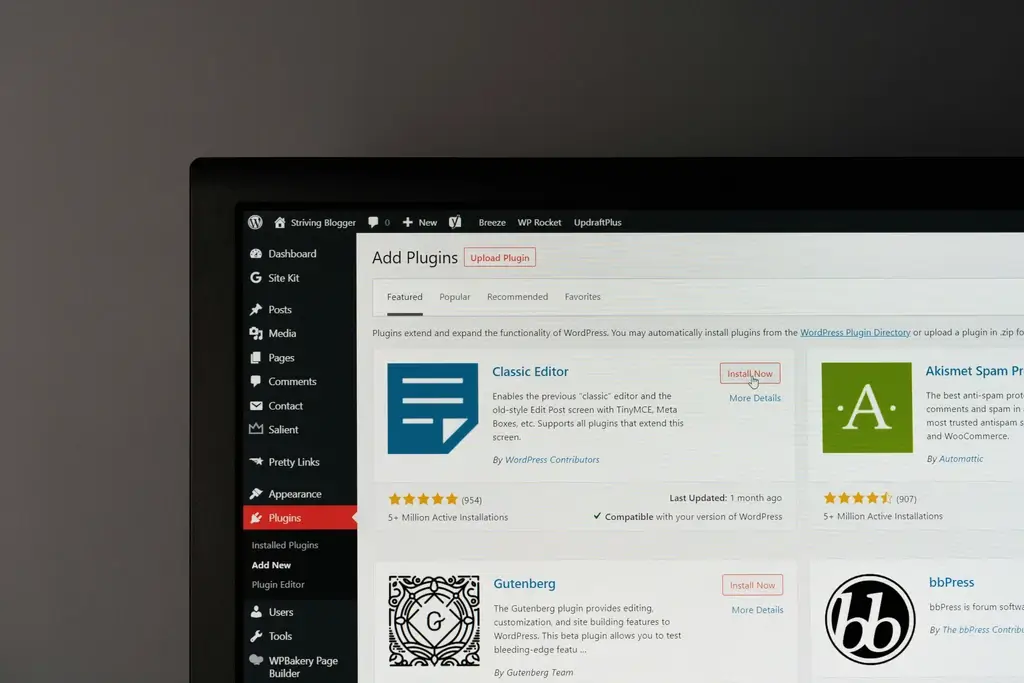Insights
The Importance Of Keeping Your WordPress Site Maintained
January 18, 2024

Written by:
So you’ve had an amazing new website built? It’s fantastic, right! Hopefully it’s incredibly quick, and it’s got the amazing new imagery you had done, along with that new content the team wrote – fantastic! But how do you prevent it becoming the outdated, slow, clunky website that you just replaced? What can you do to maintain and update your WordPress website to keep it performing? We’ve got some tips and advice for you!
It’s worth noting that these tips are aimed at non-developers. These are the kind of simple actions that marketing teams could conduct themselves, without the need for too much development support!
Plugins – Keep On Top Of Them.
Depending upon how your site has been built, it’s likely that plugins have been used to help deliver certain pieces of functionality for your site. In some ways, plugins are great – and can make difficult jobs really simple, but they do introduce an additional layer of maintenance.
Sometimes the developers of these plugins might discover vulnerabilities or issues with their work, and they’ll release new and updated versions of their plugin. You can keep on top of these in WordPress, and ensure that your site is using the latest version of available plugins.
Most plugins also now allow you to set automatic updates too. In one way, this is handy because it minimises your workload and automates this process – however, there are some instances in which you might not want to update a plugin.
Sometimes it might actually be prudent to not use the latest version of a plugin however, as often plugin developers might accidentally introduce another problem or issue in trying to update their work. It’s prudent to test updated plugins on a staging site (if you have one), or wait a period of time before updating to the latest version of a plugin (if the cause behind the latest version is something you’re able to live with).
Top Tip: You can find your list of plugins in the left-hand side admin panel when you’re logged into WordPress. Depending upon the number of plugins on your site, we’d suggest checking in here either weekly or fortnightly.
Speed Test Repeatedly.
Testing your site regularly with tools like Google’s Page Speed Insights, Pingdom, and GTMetrix is a great habit to get into. Not only because it’ll give you an indication of how quick your site is loading for your users, but because it highlights a lot of general “health” indicators for a WordPress site.
For example, it might highlight tags or scripts which have been added to the website over time which are bloating your pages and causing a slower loading time. Alternatively, it might help pinpoint those images and files that have been added to your site but haven’t been compressed to a more manageable size.
Top tip: These are (mostly) free, simple tools that can help pinpoint a variety of problems. We’d suggest testing your site on these tools on a monthly basis.
Update Your WordPress Version.
Making sure that WordPress is up to date is probably the most obvious task on this list, but that doesn’t make it any less important! This is definitely one that should be done regularly, and as soon as possible. We’ll come onto this a bit later on too, but it’s also good practice to take a back-up of your site before committing to updating WordPress.
Just like we advised with plugin updates, it’s also best practice to update your WordPress version on a staging site too – if you have one. This is particularly prudent for major WordPress updates too. You can simply update the version of your staging site, and give everything a good test to make sure that key functionality is all working as expected, and that nothing has broken. It’s not unheard of that updating WordPress versions can cause functionality issues on sites, so it is always best to play it safe.
Top tip: You’ll see a notification at the top of your WordPress admin panel, when you log in, if a WordPress update is available. Major updates happen a couple of times per year, maybe, and minor updates happen pretty regularly. We’d advise checking in on this one either every fortnight or every month.
Remove Unused Files.
Probably one of the most frustrating issues when trying to optimise and manage a website is simply trying to battle the clutter that can naturally emerge over time.
It’s almost unavoidable, but in its life cycle, you will collect hundreds of images, videos, and other files that once had a purpose, but are no longer used, and now just sit there collecting dust. The result will be that the nice, tidy new server that you likely purchased when launching your new website, is now full of stuff that you don’t even remember!
Unless you’re invested a significant amount of money, the chances are your hosting solution will limit you for file storage in some way, so it really is best practice to ensure you’re regularly purging your site of images or files that are no longer being used.
Similarly, consider the back-up schedule of your site too. How frequently do you need to take back-ups? How far back would you like to have a back-up from? Decisions here can shape how much storage space you’re going to use.
Top tip: It’s helpful to think of your server like your loft or attic. Sure, it’s great to store the golf clubs up there in the winter, but it can’t just be a dumping ground for everything – eventually you’re going to have to sort through it all and it’s going to be a nightmare! For us, this is simply an ongoing process.
Check 404s / Broken links.
As you add and remove pages over time, it’s likely you’re going to end up with some broken internal links, or even external links where you’d sign-posted third-party content, but it’s since either been removed or changed URL.
These can easily go unnoticed as you manage the site, but it can be particularly frustrating for a user if they’re navigating around your website and they keep coming across broken links or 404s.
Top Tip: There are lots of plugins and online tools you can use to check for broken links and 404s, but our preferred method would be using Screaming Frog’s SEO Spider tool. We’d suggest checking these on a monthly basis.
Testing Forms.
You’d be amazed how many people build websites, and naturally place all the importance on the forms – as their key conversion point – but then rarely test them again after a website launch. For us, testing forms is crucial – once you’ve convinced a user to purchase your product or sign up to your service, it’s imperative that the form works and doesn’t present an obstacle to the user.
We use automated testing tools like Ghost Inspector to run automated tests across our client websites – that way we know immediately if there’s an issue and we can hop right on it.
However, there’s also no substitute for conducting manual testing either. It’s important to use your website like a user would, across a range of devices, so you can get a feel for any functionality issues or bugs that might prevent them from converting.
Top tip: We’d recommend conducting some user testing in your workplace – perhaps asking for volunteers – once a month at least.
Taking Site Back-Ups.
Last, but not least – remember to take regular, full back-ups of your WordPress website.
This is arguably the most important maintenance task you can do. Taking complete, manual back-ups provides you an absolute failsafe to return to, should something drastic happen.
The positive is that most hosting solutions take automated back-ups for you, very regularly. If you’re like me and fear the worst, taking secondary manual back-ups as an extra precaution is also a good idea. Sure, you might never need them, but you’ll certainly be pleased you did take them if ever have an issue with the back-ups taken by your hosting provider.
Top tip: It’s worth checking your hosting settings to see how frequently these are scheduled for, what the deletion and storage rules are, etc. You never want to be finding out for the first time what back-ups your hosting provider has taken in a blind panic – always better to dedicate time to it in advance of actually needing it.
—
Hopefully these tips will help you keep on top of the maintenance of your amazing new WordPress website. However, if you do require more support in maintaining and optimising your new site, get in touch with us today – we’d be happy to help.
WRITTEN BY
David Berry
AGENCY DIRECTOR




